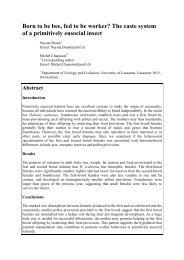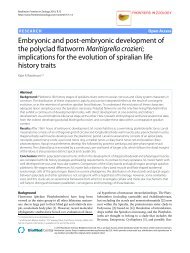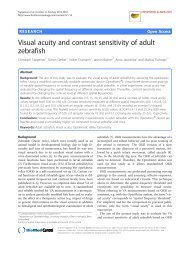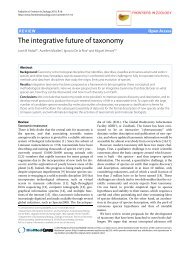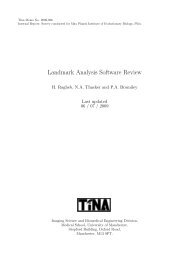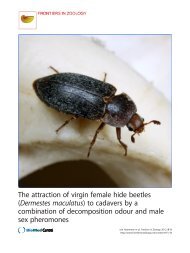Provisional PDF - Frontiers in Zoology
Provisional PDF - Frontiers in Zoology
Provisional PDF - Frontiers in Zoology
You also want an ePaper? Increase the reach of your titles
YUMPU automatically turns print PDFs into web optimized ePapers that Google loves.
Menzel et al. <strong>Frontiers</strong> <strong>in</strong> <strong>Zoology</strong> 2013, 10:32 Page 8 of 12<br />
http://www.frontiers<strong>in</strong>zoology.com/content/10/1/32<br />
quantitative (but not qualitative) differences (e.g.<br />
between conspecific colonies) is hampered <strong>in</strong> longcha<strong>in</strong><br />
hydrocarbon profiles (probably due to their<br />
low volatility), at least for Camponotus [10,11]. The<br />
crematoenones seem to reduce aggression by impair<strong>in</strong>g<br />
recognition of qualitative differences as well, thereby<br />
complement<strong>in</strong>g the chemical tolerance mechanisms<br />
between the parabiotic partners.<br />
Interest<strong>in</strong>gly, the red Ca. rufifemur variety did not show<br />
any aggression even towards allocolonial Crematogaster<br />
workers. Hence, appeasement allomones would not be necessary<br />
here. However, the red and the black Ca. rufifemur<br />
varieties are sympatric and occur at similar abundances.<br />
Parabioses probably orig<strong>in</strong>ate from Cr. modiglianii nests<br />
be<strong>in</strong>g colonised by Ca. rufifemur [7]. S<strong>in</strong>ce Cr.<br />
modiglianii is parabiotic with both Ca. rufifemur varieties,<br />
it may not be able to <strong>in</strong>fluence whether it is<br />
colonised by a black or a red Ca. rufifemur. Hence, it<br />
should produce appeasement allomones to allow a<br />
beneficial colonisation by both varieties, even if they<br />
are only necessary for a parabiosis with the black<br />
variety.<br />
Ecological and evolutionary implications<br />
To date, the use of appeasement substances has been<br />
reported only for one other ant-ant association. The<br />
slave-mak<strong>in</strong>g ant Polyergus rufescens uses decyl butyrate<br />
from its Dufour’s gland to calm its host’s aggression<br />
dur<strong>in</strong>g host-colony usurpation [4,32]. However, this appeasement<br />
function is controversial s<strong>in</strong>ce decyl butyrate<br />
acted as a repellent <strong>in</strong> a further study, thus suggest<strong>in</strong>g<br />
repellence rather than appeasement [33]. In contrast,<br />
crematoenones appease rather than repel s<strong>in</strong>ce Ca.<br />
rufifemur does not avoid contact with Cr. modiglianii<br />
workers (e.g. when forag<strong>in</strong>g) and even approaches them<br />
for trophallaxis [7]. This would not be the case if they<br />
were repellent [33]. Although certa<strong>in</strong> other social parasites<br />
use ‘propaganda’ substances to elicit panic among<br />
their hosts [3,5], we are not aware of any other case of<br />
appeasement substances among ants. Recently, however,<br />
sesquiterpenes that were not synthesized de novo, but<br />
acquired from the environment, were reported to have a<br />
calm<strong>in</strong>g effect on other species <strong>in</strong> communally nest<strong>in</strong>g<br />
st<strong>in</strong>gless bees [34]. S<strong>in</strong>ce the parabiosis is beneficial for<br />
both ant species, the appeasement benefits both on the<br />
long term.<br />
Camponotus rufifemur and Cr. modiglianii share a<br />
nest, and each species tolerates the other completely,<br />
<strong>in</strong>clud<strong>in</strong>g the brood [7]. Camponotus rufifemur is a<br />
species of relatively large ants that easily drives away<br />
other ants from its nest [7] and from food resources<br />
(FM pers. obs.). However, it tolerates the much smaller<br />
Crematogaster modiglianii [7] but attacks other<br />
Crematogaster species [9]. As the present study<br />
reveals, this tolerance is likely caused by<br />
crematoenones (although a def<strong>in</strong>ite statement would<br />
only be possible with synthetic crematoenones). Interest<strong>in</strong>gly,<br />
Ca. rufifemur does not defend itself if it is<br />
attacked by allocolonial Cr. modiglianii [9], which additionally<br />
argues for their appeas<strong>in</strong>g function. The evolution<br />
of these appeasement substances presumably<br />
enabled Cr. modiglianii to share a nest with Ca.<br />
rufifemur <strong>in</strong>stead of be<strong>in</strong>g displaced. This is beneficial<br />
for Cr. modiglianii s<strong>in</strong>ce it can take advantage of additional<br />
nest space provided by Ca. rufifemur through<br />
wood excavations and carton constructions [7].<br />
Camponotus rufifemur uses Cr. modiglianii trails to<br />
f<strong>in</strong>d food sources [35], and possibly also to f<strong>in</strong>d a Cr.<br />
modiglianii nest [7]. The two species forage together<br />
without overt aggression although they have overlapp<strong>in</strong>g<br />
food niches and thus are potential competitors for food<br />
[36]. Thus, the crematoenones may also benefit Cr.<br />
modiglianii <strong>in</strong> that they prevent it from be<strong>in</strong>g displaced<br />
from food. Otherwise, Ca. rufifemur would essentially<br />
parasitize on Cr. modiglianii, follow<strong>in</strong>g its pheromone<br />
trails to food sources and then displac<strong>in</strong>g Cr.<br />
modiglianii foragers. These hypotheses match other<br />
cases of mutualisms that evolved from parasitic associations<br />
where the host acquired adaptations to cope<br />
with the parasite [37,38].<br />
Interest<strong>in</strong>gly, <strong>in</strong> all reports on parabiotic associations,<br />
one of the two parties is a Crematogaster species<br />
[39].Thepartnerspecies,i.e.membersofCamponotus,<br />
Odontomachus, Pachycondyla or Dolichoderus [39], are<br />
essentially all larger, and therefore probably more competitive,<br />
than Crematogaster. Intheneotropics,asimilar<br />
parabiosis exists between Camponotus femoratus<br />
and Crematogaster levior [8]. This association is also<br />
characterized by high <strong>in</strong>terspecific tolerance between<br />
the two species, and low <strong>in</strong>ter-colony discrim<strong>in</strong>ation (FM<br />
and TS, unpublished data). Similar to Cr. modiglianii, Cr.<br />
levior produces non-hydrocarbon cuticular substances (FM<br />
and TS, unpublished data). However, their structure and<br />
function are not elucidated yet. It seems possible that, as <strong>in</strong><br />
the case studied here, the Crematogaster-specific ability to<br />
synthesize additional cuticular compounds with appeasement<br />
or similar functions was crucial for the evolution and<br />
ma<strong>in</strong>tenance of these parabioses.<br />
Conclusions<br />
Crematogaster modiglianii produces a substance class<br />
(‘crematoenones’) that was unknown from nature<br />
until now. In behavioural assays, crematoenones reduced<br />
aggression of Camponotus rufifemur. S<strong>in</strong>ceCr.<br />
modiglianii and Ca. rufifemur live and forage together<br />
despite be<strong>in</strong>g food competitors [7,35,36], it seems<br />
likely that crematoenones help Cr. modiglianii to evade<br />
Ca. rufifemur aggression, <strong>in</strong>clud<strong>in</strong>g displacement from




